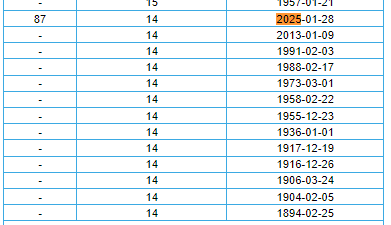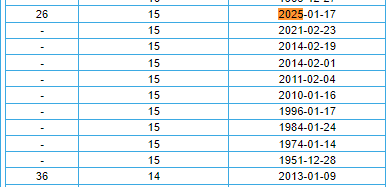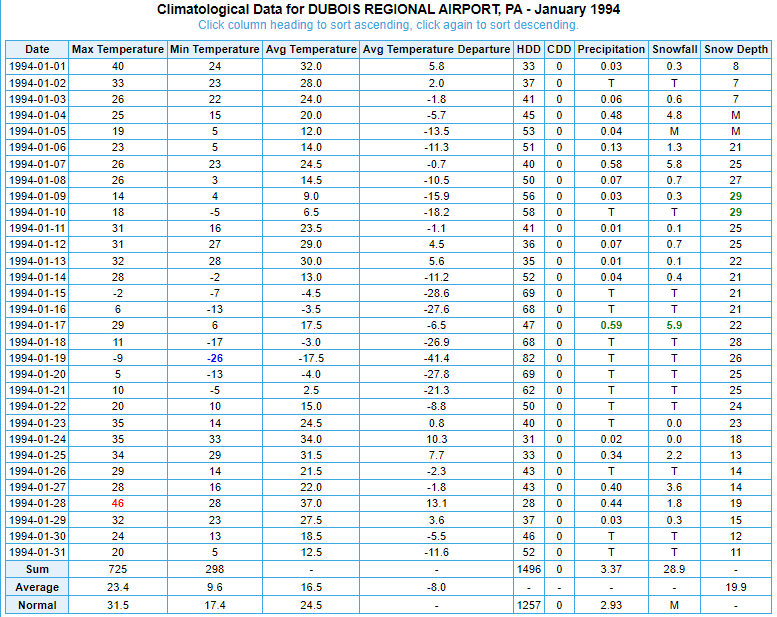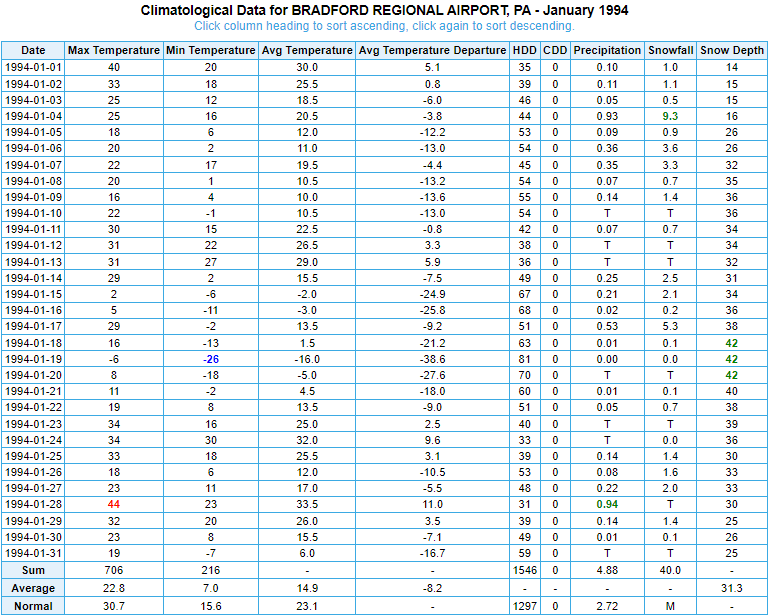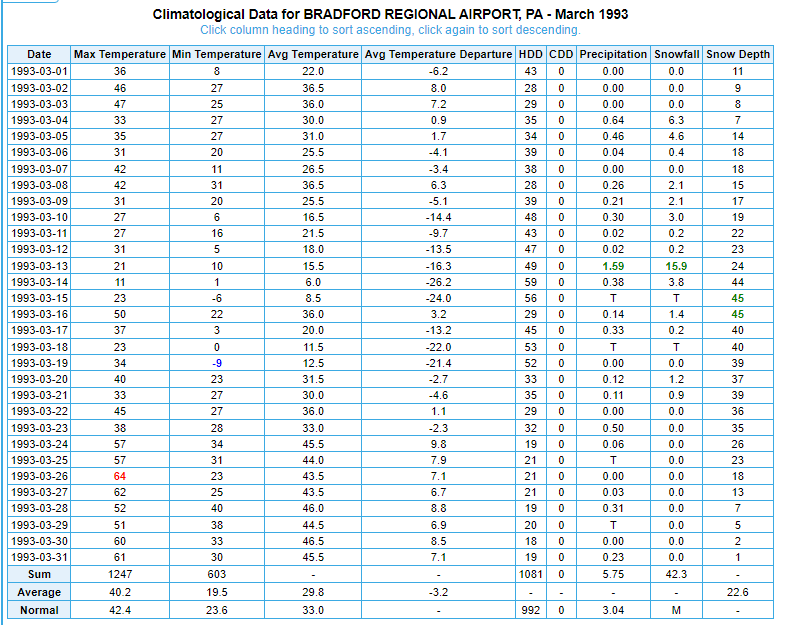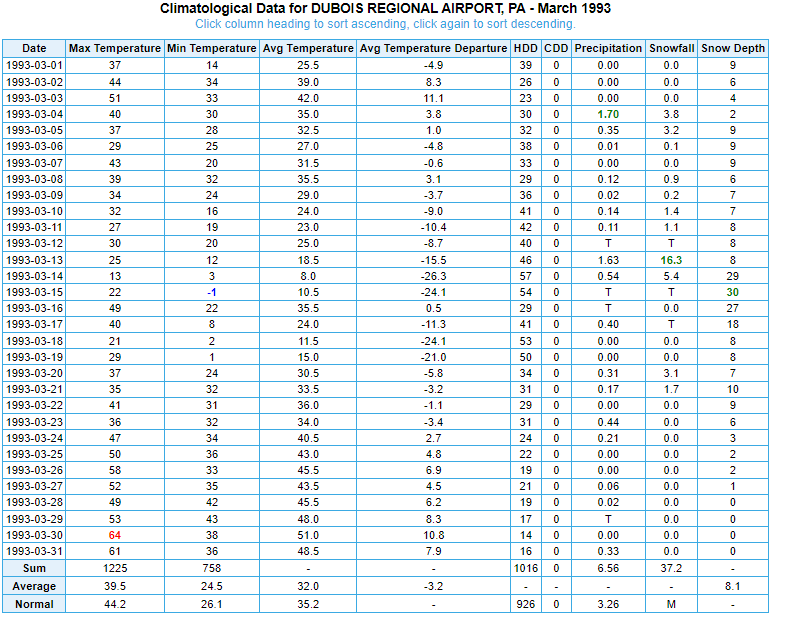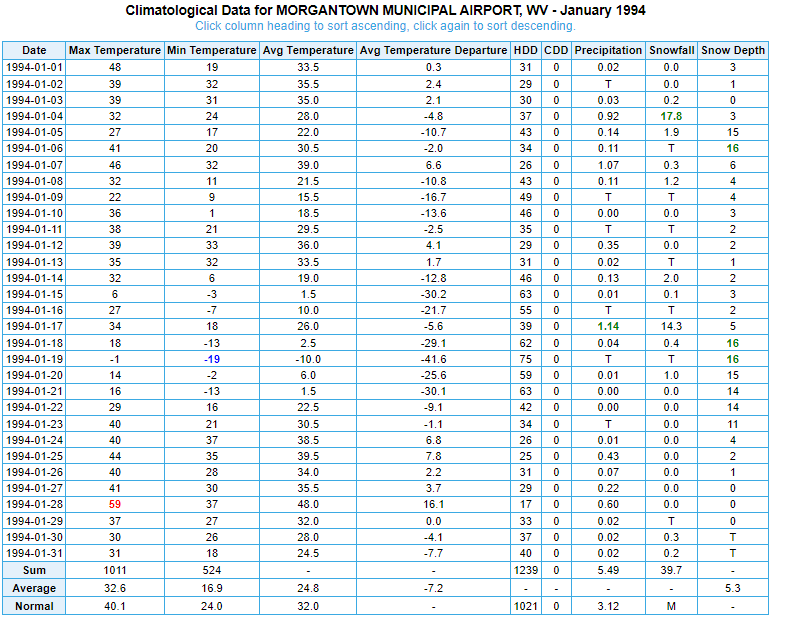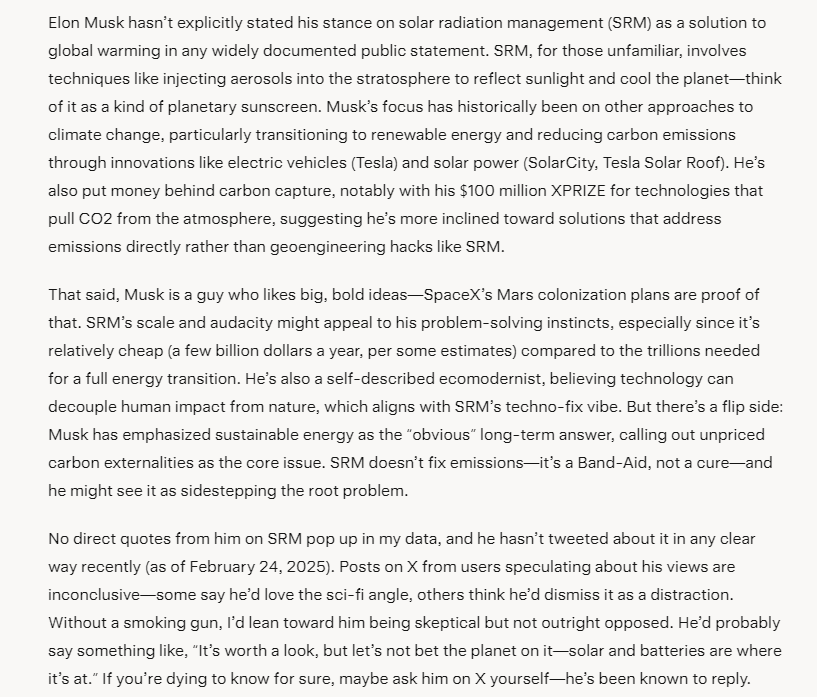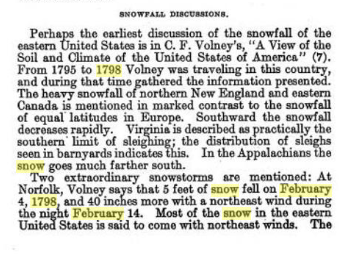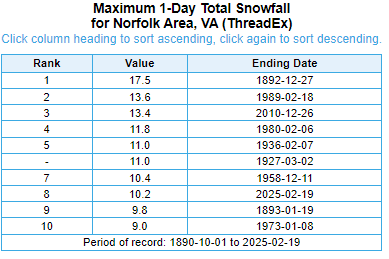
TheClimateChanger
Members-
Posts
4,041 -
Joined
-
Last visited
Content Type
Profiles
Blogs
Forums
American Weather
Media Demo
Store
Gallery
Everything posted by TheClimateChanger
-
We were talking about historic snows and I mentioned February 1798 in Norfolk, and one of the citations I saw given for that storm was to C. F. Volney's "A View of the Soil and Climate of the United States" (1803), so I decide to read this book. And I was quite surprised because he mentions parakeets [paroquets] overwintering in the valley of the Scioto River. I'm thinking "parrots in Ohio" - this guy must have been off his rocker. It turns out there were literally parakeets in Ohio (and elsewhere in the eastern and central United States) and we killed them all. Insane. Source: Carolina parakeet - Wikipedia
-
There's no reason to believe that we would have reverted to even Pliocene conditions in the absence of manmade climate change any time in the near future. I suppose in hundreds of millions of years, the luminosity of the sun may have increased enough to create a new hothouse earth. Why do you think the climate should have reverted back to the conditions that were present millions of years ago? The Pleistocene began circa 2.8 mya and there have been periodic large-scale glaciations during that whole time.
-
I mean we have a pretty good idea of both, especially 24k years ago. That wasn't far from the last glacial maximum. Pretty sure it was considerably colder than today, and we've known that since at least the early 19th century.
-
Pittsburgh/Western PA Winter 2024-2025 Thread
TheClimateChanger replied to Rd9108's topic in Upstate New York/Pennsylvania
Well, snow is a different beast. More frequent observations can result in a huge mismatch between the "snowfall" and what has actually accumulated on the ground. Even 6-hourly observations can result in a boost of 15-20 percent versus the maximum depth from a storm. In the past, snowfall was typically measured once daily or even estimated using a 10:1 ratio from its melted liquid equivalent, or in some cases just a measurement of the change in snow depth. The current procedure didn't become common until the 1950s to as late as the 1990s at some first order sites. Source: Snowfall measurement: a flaky history | NCAR & UCAR News -
Pittsburgh/Western PA Winter 2024-2025 Thread
TheClimateChanger replied to Rd9108's topic in Upstate New York/Pennsylvania
The guidelines say that scenario is 3" of snow. The instructions here are for 24-hour observations, as that is the common practice for cooperative stations: one daily measurement, typically in the morning. This also suggests you can sum if it partially melts. I guess you'd have to also record what the depth dropped to, in order to determine the new snowfall, since the board cannot be cleared more than once in six hours. Source: Snow Measurement Guidelines -
Let’s talk winter!! Ohio and surrounding states!! 24'-25'
TheClimateChanger replied to buckeye's topic in Lakes/Ohio Valley
I mean it goes without saying that I am assuming he didn't actually observe 1" or more of snow cover for 60 days straight. There have been thaws. No place in the region has seen any unusually length of continuous snow cover. If he's in the woods, then, perhaps some traces of snow/ice persisted the whole time, but that's different and also probably not that unusual. 60 days of continuous snow cover would be very rare [not unprecedented, however], but three or four weeks of continuous snow cover is not at all uncommon for Ohio. Looks like for northern and north central Ohio, the historical frequency of such a stretch is from about 1 in every 3 winters. The longest streak at Cleveland this winter was 14 days. A value which has been exceeded 86 times and matched in at least 13 other years. This is a bit misleading since I believe most places in northern Ohio had longer stretches... For instance, Canton-Akron Airport had snow cover of 1" or greater for 28 days in a row ending on 1/30. But even that length has been met or exceeded in 21 other years since 1948. So even a full 4 weeks of snow cover (i.e., about a month) there occurs about once in every 3.5 years on average [and the frequency had been greater until recent years]. Columbus had 1" or more of snow cover for 15 days, ending 1/17. A streak that long has occurred 35 other times since 1948, or a little less frequently than every other year on average. Detroit's longest stretch this winter was 19 days ending on 1/29, a length which has been met or exceeded 52 times since 1948. On average, approximately 2 out of every 3 winters see this. It's actually more common than not at Detroit to see a stretch of about 3 weeks of continuous snow cover at some point in the winter. -
Occasional Thoughts on Climate Change
TheClimateChanger replied to donsutherland1's topic in Climate Change
-
Occasional Thoughts on Climate Change
TheClimateChanger replied to donsutherland1's topic in Climate Change
The reality is the only record I think we can rule out at this point is 2025 will not be the coldest year on record for the United States. Because, unless Yellowstone blows tomorrow, that isn't happening. -
Occasional Thoughts on Climate Change
TheClimateChanger replied to donsutherland1's topic in Climate Change
This guy is so annoying. Like, dude, your map ends on February 21. February 2015 was way colder in most areas, and that ended up being the 2nd warmest year on record for the CONUS (still like 6th or 7th). Does it make it more difficult to set a record? Yes. What also makes it more difficult is all the recent unbelievably hot years. Like I said, 2015 was second only to 2012 at the time, and now several more years have since passed it! Can we rule out a record high on February 21? I don't think so, especially not with all of the warm anomalies globally. We have been under a small blue blob, what happens if we enter under a massive red blob in spring and summer in an atmosphere that's been globally warmed by 1.5C? -
Pittsburgh/Western PA Winter 2024-2025 Thread
TheClimateChanger replied to Rd9108's topic in Upstate New York/Pennsylvania
They didn't seem to inflate the snowfall totals as much as we do these days. When 20" fell, the depth increased by 20 inches. -
Pittsburgh/Western PA Winter 2024-2025 Thread
TheClimateChanger replied to Rd9108's topic in Upstate New York/Pennsylvania
Back in those days, northern PA seems to have had 30+" depths pretty frequently. Ignore the snowfall total here, since it's missing the big snow on the 5th. It's a shame we don't have observers in most of these places, but I suspect depths like this don't happen too frequently these days, even in the higher elevations. DuBois Bradford - wow, 3 1/2 feet of snow, with an average snow depth over 31" per day. -
Pittsburgh/Western PA Winter 2024-2025 Thread
TheClimateChanger replied to Rd9108's topic in Upstate New York/Pennsylvania
Definitely the good old days of yore. Here is what MGW observed from when they still had snow observations. -
Good call. MLI is up to 60F. As an aside, it's crazy to me how fast that February monthly record high maximum has jumped in recent years. The long-standing record was 73F from 2/15/1921. In 2017, it tied this value 3 times and beat it once (74F, on 2/19/2017). Last year, it reached 76F on February 26, and an absolutely insane 79F on February 27. You have to think the first 80F February reading is right around the corner.
-
Let’s talk winter!! Ohio and surrounding states!! 24'-25'
TheClimateChanger replied to buckeye's topic in Lakes/Ohio Valley
I'm just going off of xMacis. Looks like it's pretty typical for Ohio in a historical sense. Obviously, you may have done somewhat better in rural Knox county. xMacis reports CMH has had 23 days with 1" or more, which is only 36th most since 1948, and even that exaggerates the rarity versus limiting the comparison to the 1950 to early/mid 90s time frame. CLE has had 38 days of 1" or more snow cover. Looks like 69 other years have had as many or more [out of 133 years], and that includes a bunch of years from downtown where the snow cover would be less resilient. CAK has also had 38 days of 1" or more snow cover, which is a bit more impressive. But even still 35 other years had at least that many [out of 76 years with sufficient data], so pretty much par for the course [at least historically]. -
Occasional Thoughts on Climate Change
TheClimateChanger replied to donsutherland1's topic in Climate Change
At this point, it would seem catastrophic climate change cannot be avoided by emission reductions alone, so some form of geoengineering - whether it be direct air carbon capture, or some form of solar radiation management - is likely needed to avoid catastrophic climate change. My review of past climate change suggests there were glacial-free areas in the early Holocene in areas where there are now glaciers, and there may have been less summertime ice coverage. Global average temperatures during this period were very likely less than present temperatures but may have been as warm as early 20th century temperatures. However, this period of relative warmth lasted for thousands of years. Considering all reputable reconstructions suggest we have blown past the temperature at any point in the Holocene, to me, this suggests EXTREME changes will occur even with no further warming, including most likely a seasonally ice-free arctic ocean with substantial melting of montane glaciers and reduction in continental ice shelfs leading to significant sea level rise. Again, this assessment is based on NO FURTHER WARMING, but rather comparing similar, but cooler time frames to the present. It may even be the case that we are approaching the warmest period in 2.6 million years, although I cannot rule out some slightly warmer interglacials during the Pleistocene. In reality, we continue to quickly warm and will likely blow right past even the warmest of Pleistocene interglacial periods - perhaps, in a worst-case scenario, even reaching PETM levels. For the life of me, I cannot figure out how the IPCC safety zone of 1.5C or 2C was calculated - those are massive changes, corresponding to some of the warmest periods in the last 2.6 million years. It would be asinine to believe the earth could withstand such a massive climate change without dire consequences over the coming centuries. -
Occasional Thoughts on Climate Change
TheClimateChanger replied to donsutherland1's topic in Climate Change
I remain cautiously optimistic that the current administration may deploy a system of solar radiation management within the next 4 years or at least have a plan to implement such a system in the near future within the next 4 years, given its focus on technical solutions to the problems facing society. When prompted with a question about Elon's openness to implementing solar radiation management, Grok gave this response: -
Let’s talk winter!! Ohio and surrounding states!! 24'-25'
TheClimateChanger replied to buckeye's topic in Lakes/Ohio Valley
Believe it or not, this used to be normal! -
Unbelievable. I was reading C. F. Volney's "A View of the Soil and Climate of the United States" from the early 1800s, and he noted the mild winters of the Ohio Valley and that parakeets overwintered in the Valley of the Scioto River. I thought, no way, there are no parakeets in Ohio. What the absolute bleep? There used to be parakeets in Ohio and we killed them all? Why did we kill all of the Ohio parakeets? This is an absolute travesty! Source: Carolina parakeet - Wikipedia
-
From the January 1915 Edition of the Monthly Weather Review, which was also published by Charles Franklin Brooks. The origination of the claim comes from C. F. Volney's "A View of the Soil and Climate of the United States of America" which was based on his observations from 1795 to 1798. I can't find any other source for the February 4, 1798, but there are surviving newspaper records of the February 14, 1798 storm and it is noted in Ludlum's work from 1963. Per Ludlum, it was reported that up to four feet of snow fell in parts of coastal North Carolina.
-
While it wasn't quite a redux of February 1798 for Norfolk, yesterday was the 8th highest calendar day snowfall on record since October 1, 1890. And the eighth time on record with 10 or more inches of snow in a single calendar day. In 1798, old records suggest as much as 60 inches fell on February 4, followed by another 40 inches on the 14th, with the Norfolk Herald and New York Spectator indicating snow depths as high as six feet on the level. Excerpt from "Why the Weather?" by Charles Frankin Brooks (1924). More insight on the February 14, 1798 storm:
-
Just a perfect storm. Increased human-induced forcing, and it looks like whatever natural processes were in play for a few decades to keep the radiative forcing trend below the human-induced warming trend have reversed over the past several years [as both are now, more or less, on top of one another].
-
One thing you have to wonder about is what is going on behind the scenes. I know a little while back, Elon Musk said he was more worried about CO2 becoming so high that it would be difficult to breathe. But this makes little sense. I was always under the impression that climate impacts would become catastrophic well before we reached those levels of CO2. You have to wonder if the U.S. government doesn't have contingency plans in place for solar radiation management. That comment would only seem to make sense if you believed we could engineer our way out of the temperature rise, but would not be able to withdraw enough carbon to prevent breathing impacts? Given Elon's ties to the U.S. government through SpaceX, you have to wonder if there isn't a plan in place to funnel taxpayer money to SpaceX in exchange for implementation of solar radiation management. In my opinion, we have already accidentally geoengineered our way to a Pliocene climate and seem well on our way to recreating the Eocene or Paleocene, maybe PETM in a bad case. As the U.S. government bureaucracy always has plans for just about every event, you have to assume they know full well how bad things really are. I mean they are blabbing on about a 2.5% chance of an asteroid hitting in 2032 and possibly needing to divert its course. Given how corrupt our government is (and I think people on both sides of the political aisle would agree with that statement), you have to wonder if there's really even an asteroid in danger of striking earth - or if it's not just another scheme to funnel taxpayer money to SpaceX to blow up a fake asteroid.
-
Pittsburgh/Western PA Winter 2024-2025 Thread
TheClimateChanger replied to Rd9108's topic in Upstate New York/Pennsylvania
Overall, you can't complain about how this worked out. Last week, it looked as though Chicago and Detroit were going to get lots of snow from this, and then the East Coast was going to get hammered by a blizzard later this week. In fact, Chicago saw little snowfall and Pittsburgh wound up with more snow than Detroit (although the first wave, of course, melted off here). And the East Coast is not getting a blizzard. -
Pittsburgh/Western PA Winter 2024-2025 Thread
TheClimateChanger replied to Rd9108's topic in Upstate New York/Pennsylvania
Was the report from 7 pm for sure? Technically, it is possible for it to snow but not result in any additional accumulation if the earlier report was an interim report. Snowfall guidelines say the accumulation is the maximum depth on the snow board in the 6-hour period. So, it could be possible that the depth was 2.6" on the snow board and additional snow fell over the six-hour period but the depth never exceeded 2.6" until the snow board was cleared due to compaction of the earlier fallen snow. Also, as you noted, snowfall and snow depth are recorded at the NWS office, which is close to the airport but not on the airport grounds. -
Pittsburgh/Western PA Winter 2024-2025 Thread
TheClimateChanger replied to Rd9108's topic in Upstate New York/Pennsylvania
I think the 3.5" was the total from the NWS. They reported 2.6" on the 16th, and then 0.9" on the 17th, so that would line up with the 24-hour report of 3.5" as of 7 am yesterday.




